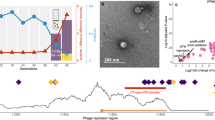Summary
In order to explain several discrepancies between the gene-recombination phenomena in phages and in higher organisms, we assume that theT 2 phage, after entering the bacterium, divides in three parts corresponding to the three “chromosomes' whichHershey andRotman have traced in this phage. The three parts are supposed to be able to divide further by rupture or by the action of other “chromosome fragments”. Each fragment is supposed able to reproduce inside the bacterium as a more or less independent unit and before lysis of the bacterium the various parts are assumed to reunite in complete sets of genes each forming a new phage.
After discussing the experimental facts supporting these assumptions, we show that the assumptions are in perfect agreement with the theory of the symbiosis of genes, a theory which seems necessary in order to explain the ability of the “chromosome-fragments” to reunite into complete phages.
Also the problems arising with respect to the sexual reproduction in bacteria is discussed under the point of view of the symbiosis theory. The assumption is made that the hereditary material is transduced from bacterium to bacterium by ultramicroscopic virus-like particles “genophores”. In several lysogenic bacteria the genophores are supposed still able to act as parasites (phages) instead of symbiontes towards some other sensitive bacteria. The experimental facts supporting this assumption are analyzed, and new experimental tests suggested.
Similar content being viewed by others
Literature
Barricelli, N. Aall (1947). The hypothesis of the gene-symbiosis and its importance in the explanation of the origin of the garnic reproduction. — Oslo, Cammermeyers Boghandel, 9 p.
— (1952). Mikroorganismenes genetikk. — Naturen, Nr 6, p. 162–191.
Cavalli-Sforza, L. L. (1950). La sessualitá nei batteri. — Boll. Ist. sieroter. Milano XXIX.
Delbrück, M. (1949). Génétique du bactériophage. — Colloq. int. Cent. nat. Rech. sci. VIII (Unités biol. Contin. génét.), p. 91–103.
Hershey, A. D. &R. Rotman (1948). Linkage among genes controlling inhibition of lysis in a bacterial virus. — Proc. nat. Acad. Sci., Wash. XXXIV, p. 89–96.
Keller, B. (1933). Botany on a physiological basis. — Selkhozgiz.
Kozo-Poliansky, B. (1924). Outline of a theory of symbiogenesis. — Selkhozgiz.
Lederberg, J. (1947). Gene recombination and linked segregations inE. coli. — Genetics XXXII, p. 505–525.
Luria, S. E. (1947). Reactivation of irradiated bactériophage by transfer of self-reproducing units. — Proc. nat. Acad. Sci., Wash. XXXIII, p. 253–264.
— &R. Dulbecco (1949). Genetic recombination leading to production of active bacteriophage from ultraviolet inactivated bacteriophage particles. — Genetics XXXIV, p. 93–125.
Oparin, A. I. (1938). The origin of life. (Transl. with annotations by S. Morgulis). — New York, Macmillan, xii+270 p.
Tatum, E. L. &J. Lederberg (1947). Gene recombination in the bacteriumE. coli. — J. Bact. LIII, p. 673–684.
Zinder, N. D. &J. Lederberg (1952). Genetic exchange inSalmonella. — J. Bact. LXIV, No. 5, p. 679–699.
Author information
Authors and Affiliations
Rights and permissions
About this article
Cite this article
Barricelli, N.A. On the manner in which crossbreeding takes place in bacteriophages and bacteria. Acta Biotheor 11, 75–84 (1955). https://doi.org/10.1007/BF01602633
Received:
Issue Date:
DOI: https://doi.org/10.1007/BF01602633



